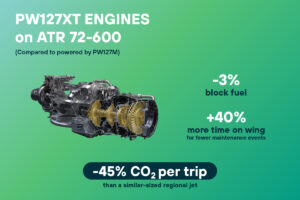Source: ATR

As the world’s leading manufacturer of regional aircraft, ATR has built almost 1,700 turboprops with 48 to 78 seats since its inception in 1981. Our aircraft are designed to be robust, capable of landing on all kinds of terrain, and cost-effective to operate for airlines, while providing comfort, safety, and cutting-edge technologies to passengers. Our aircraft operate in some of the most remote corners of the world, from the Bahamas to the Baltics, offering a lifeline to many remote communities.
Addressing the Climate Challenge
ATR is fully committed to contributing to the decarbonisation of aviation, along with all industry players. In January 2024, the Science-Based Targets initiative (SBTi) validated our short-term emissions reduction targets, which include reducing absolute GHG emissions from operational processes and energy consumption by 50.4% by 2030 and reducing absolute GHG emissions generated by our aircraft fleet in service by 30%within the same timeframe, compared to 2018 levels.
To achieve these ambitious goals, we are investing in a more energy-efficient infrastructure, renewable energy, optimised manufacturing processes, and sustainable practices throughout our value chain.
Current Decarbonisation Initiatives
Our current decarbonisation initiatives are based on four pillars: continuous development of our aircraft family, sustainable aviation fuels (SAF), hybridisation with the ATR EVO, and the aircraft life cycle.
1. Continuous innovation
With new engines, the PW127XT, an ATR 72-600 burns well over 3% less fuel than with the previous engine series and emits 45% less CO2 per trip than a similar-size regional jet, saving 4,400 tonnes of CO2 per aircraft per year. Moreover, ATRs produce virtually no contrails. With 69g of CO2 emitted per seat per km, ATRs even offer a more responsible solution than single-occupancy cars. They also meet the most stringent standards for external noise.
ATRs are, by design, very suited to the challenges of our time, and ambitious plans are underway to reduce emissions even further.

2. Sustainable Aviation Fuels (SAF):
There is a consensus within the aviation industry that SAF is one of the quickest ways to significantly reduce CO2 emissions. A renewable energy source derived from organic matter, waste, or non-fossil raw materials, drop-in SAF can be seamlessly integrated into existing aircraft and infrastructure, generating about 80% fewer GHG emissions over its lifecycle compared to conventional fuel.
ATR aircraft are certified to fly with 50% SAF. In June 2022, we completed the first-ever flight with 100% SAFin both engines of a commercial aircraft.

The “book and claim” scheme:
As the availability and production capacity of SAF remain limited today, ATR supports the development of a “book and claim” mechanism, which is an effective way to scale up SAF deployment and accelerate the sector’s decarbonisation. This system allows airlines to purchase SAF from competitive sources worldwide, regardless of geographical proximity. It decouples environmental credits from physical SAF, reducing the need for global transportation and complexity. Airlines receive credits for CO2 emission reductions even if the physical fuel is used by other operators at local airports near the production site.
3. The ATR EVO:
The ATR EVO is our mid-term solution to significantly reduce emissions without compromising accessibilityand versatility, which are key assets of the ATR family. This hybrid electric aircraft concept combines a new high-performance thermal engine with an electric motor and batteries, aiming for a 20% reduction in CO2 emissions compared to current aircraft and improved performance. We aim for an entry into service by 2030+.
4. Aircraft Life Cycle:
Aircraft decarbonisation extends beyond flight phases, and must consider the entire aircraft life cycle, from design to dismantling. We are exploring new designs and materials to improve the recyclability of our aircraft. Three ATR aircraft have been recycled by our partner TARMAC Aerosave in 2023, and four ATR aircraft will be dismantled this year. Currently, 85.5% of ATR parts are recyclable or reusable, and we are actively exploring new recycling processes to increase the number of recyclable parts in the future and therefore contribute to the circular economy.
A Collaborative Effort
Decarbonising aviation cannot be achieved by a single manufacturer alone. It requires joint efforts with airlines, airports, regulators, and the entire aviation ecosystem.
As the climate challenge underscores the need for more responsible air travel, regional aviation is well-positioned to lead the industry’s transformation. ATR’s commitment to innovation and sustainability aims to ensure that all regions of the world remain connected and accessible, fostering economic development while minimising environmental impact. Together, we are designing tomorrow’s responsible air connectivity.
